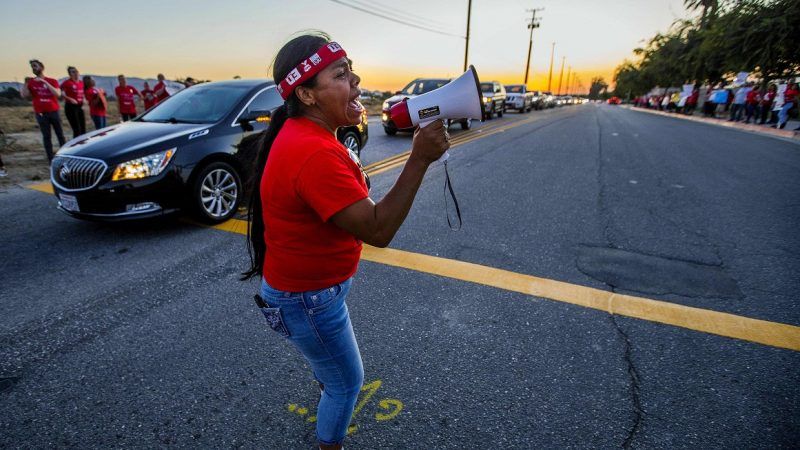A Rigged System Is Keeping a California Charter School Under Union Rule
First the union invaded, now it refuses to leave.

In 2004, Vincent Riveroll became the principal of Gompers Middle School in San Diego. On his first day, he was approached by a student who was puzzled by his outfit. "Why are you wearing a suit?" the child asked. "It's just going to get ripped when you break up a fight."
Gompers was part of an all too familiar pattern of inner-city schools suffering from routine violence, low attendance, and poor academic performance. It had been that way for years, creating a sense of hopelessness that wore down even the most committed teachers.
Every year, Gompers lost more than half its staff. Parents and reform-minded faculty wanted to keep standout teachers from leaving by rewarding them for their performance, but San Diego Education Association (SDEA) union officials fiercely opposed any changes to the pay structure, which was based strictly on seniority.
With union officials unwilling to give in, and with falling performance threatening to shut its doors, Gompers had few options. As current teacher Jessica Chapman put it, "Gompers faced three choices: close, be taken over by the state, or transition to a charter school."
A majority of Gompers parents and teachers joined together and won approval from the school board in 2005 to convert Gompers into a charter school. Free from union control and intransigence, Gompers finally flourished. Test scores rose, the violence was curtailed, and teachers dedicated to the charter school's mission were hired.
In the years since, the teacher retention rate at Gompers Preparatory Academy has been above 85 percent. It attracts teachers who want to work at a charter school free from the constraints of a contract dictated by union bosses. Despite these encouraging results, California Teachers Association (CTA) officials never accepted the decision of teachers and parents to transition Gompers to a public charter school, which freed it from union control.
Teachers union officials, including many at the CTA, have long opposed charter schools, lobbying against them with countless millions in dues money. Charter schools like Gompers threaten union officials' control over the taxpayer-funded education system, in which the government grants union officials monopoly bargaining power over all teachers, even those opposed to unionization, to impose a one-size-fits-all contract.
So despite the success Gompers had achieved since shedding the union, union officials turned to a controversial tactic known as "card check" to reimpose its monopoly control over teachers and the school. Under California law, union organizers can bypass any secret ballot election by pressuring, and often misleading, enough of the employees to sign union cards that are then counted as "votes" for the union.
According to Chapman, union agents "got signatures using deceptive tactics and ambushed the rest of us with their sudden introduction letter.…Thanks to laws pushed by the same unions, our [school] leadership was denied the right to get involved. So in January 2019 unionization was forced upon us – we were never even given the respect of a vote."
Chapman was hardly alone in her opposition to the sudden imposition of the union without an actual vote. Kristie Chiscano, a teacher who left a career as a surgeon to serve Gompers students, sought a school that wasn't unionized: "I chose to work at a school that didn't have a union and now they've come in and they're running everything about my contract and my work."
Chiscano and many of her fellow teachers wanted a secret-ballot vote to remove the union. Under California law, enforced by the Public Employment Relations Board (PERB), public employees must wait one year to request a decertification vote after a union is certified. Chiscano and others collected enough signatures from teachers (over the 30 percent needed) and planned to file the petition with the PERB soon after the one-year waiting period expired.
But when the union got wind of the teachers' push for that vote, SDEA lawyers preemptively filed "blocking charges" against the school, leading to the PERB's regional attorney blocking the decertification petition from moving forward. Now, a year after the petition, the election is still blocked because the board's rules favor union officials over independent-minded employees.
Under PERB policy, public employees' right to decertify can be blocked even if the employees who signed and filed the petition are not alleged to have done anything wrong. In deciding whether to block a vote, proof of the union officials' allegations is irrelevant because the PERB must treat them as true. So when Chiscano appealed the regional attorney's ruling blocking the decertification election, the PERB in Sacramento upheld the block because the regional official was right to assume the veracity of the union's allegations with no independent investigation.
With free legal aid from National Right to Work Legal Defense Foundation staff attorneys, Chiscano and her fellow teachers continue to fight for a vote, now two years after the union was installed without a vote and over a year after the teachers requested the decertification election. Further, foundation attorneys recently filed charges against SDEA officials for illegal retaliation against Chiscano and Chapman, after union officials published social media posts attacking the teachers for seeking a vote to remove the union.
The teachers' struggle would likely infuriate one famous union official, their school's namesake. Samuel Gompers, founder of the American Federation of Labor, believed in voluntary unionism, not coercion. He said: "The workers of America adhere to voluntary institutions in preference to compulsory systems which are held to be not only impractical but a menace to their rights, welfare and their liberty."
Yet today, rather than working to win the voluntary support of teachers, union officials have fully embraced the compulsion Gompers abhorred, even going so far as to block teachers' request to simply hold an up-or-down vote on whether they want union representation at all.


Show Comments (44)